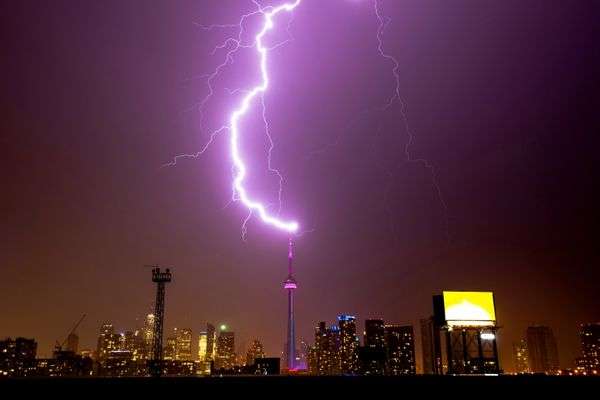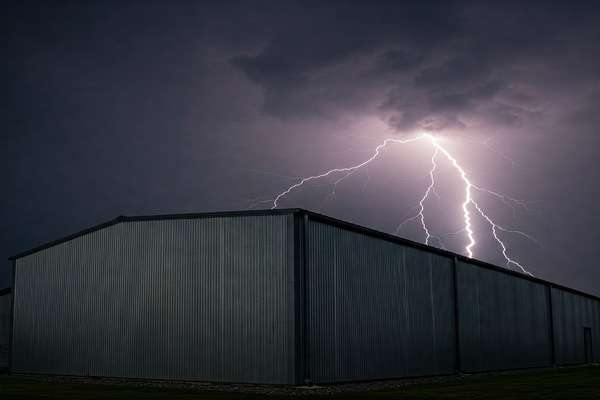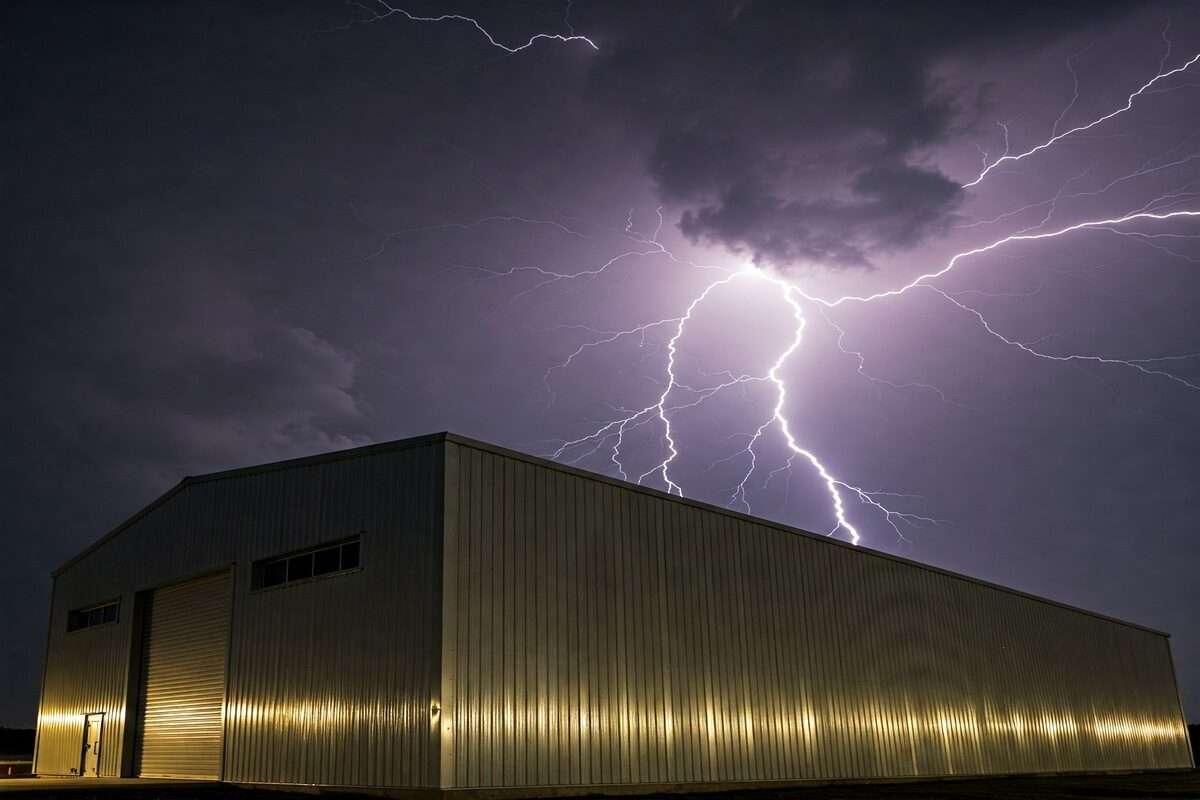Lightning safety is often misunderstood, and many assume a metal building attracts strikes. But lightning can occur even in dry conditions. It can also strike miles away from a storm. That’s why taking shelter indoors immediately is crucial. Waiting too long or staying outside puts you at serious risk.
Another widespread misconception is that rubber tires on vehicles provide insulation against lightning. The truth is, tires offer no protection at all. Instead, it’s the metal frame of the car that shields passengers by acting as a Faraday cage, safely directing the electrical charge around them and into the ground.
While metal structures offer some level of protection, they aren’t foolproof. If a metal building isn’t properly grounded, lightning can still cause electrical surges or fires, making it essential to follow proper lightning safety measures.

The Truth About Lightning and Metal Structures
Many people mistakenly believe that metal attracts lightning, but this is not true. Lightning is just as likely to strike a tree, a wooden building, or the ground as it is to hit metal. The key difference is that metal structures handle lightning strikes far better than other materials, as they can safely conduct the electrical charge into the ground, minimizing damage.
This same principle applies to metal buildings. When properly constructed, a steel frame functions like a protective cage, redirecting lightning safely away—similar to how a car protects its occupants. While no structure can offer complete immunity from lightning, metal buildings significantly lower the risk of severe damage, making them one of the safest options during a storm.
Lightning Safety: How to Protect Yourself
Lightning is one of nature’s most powerful and unpredictable forces, making personal safety a top priority whenever storms are in the area. The best way to stay safe is to seek shelter immediately. Being indoors significantly reduces your risk, but some people mistakenly believe that staying outside is safer if the only available building is made of metal.
This is completely false. In reality, metal structures provide better protection than wood during a lightning storm. Since metal conducts electricity efficiently, it safely directs lightning strikes into the ground rather than allowing them to cause damage. Additionally, metal is non-flammable, reducing the risk of fires sparked by lightning. Taking shelter in a properly grounded metal building is one of the safest options when lightning is near.

How a Metal Building Resists Lightning Damage
To understand why metal buildings are highly resistant to lightning damage, it’s important to recognize that lightning is simply a massive electrical discharge. A single bolt of lightning can generate up to 100 million volts, carrying enough energy to cause significant destruction. However, like all forms of electricity, lightning follows predictable physical laws, meaning that materials react differently to its impact.
Why Some Materials Are More Vulnerable to Lightning
Every material either conducts or resists electricity to some degree. Non-conductive materials like wood, brick, or concrete have high electrical resistance, meaning they do not allow electricity to flow through them easily. When lightning strikes these materials, its energy cannot dissipate efficiently, which often leads to fire, explosions, or structural damage.
For instance, in the U.S., fire departments respond to approximately 22,600 fires caused by lightning every year. These fires occur in homes, churches, lumberyards, and non-residential buildings, leading to an estimated $8–$10 billion in damages annually. Specifically, lightning is responsible for 30% of church fires, 19% of residential fires, 18% of lumberyard fires, and 14% of outdoor burns. These statistics highlight how vulnerable traditional structures can be.
Why Metal Buildings Offer Superior Protection
Unlike wood, metal is an excellent conductor of electricity. Instead of resisting lightning’s energy, a properly grounded steel structure allows the electrical current to pass through its frame and safely into the ground. This controlled transfer of energy prevents dangerous heat buildup, significantly reducing the risk of fire or structural failure.
Think of a metal building like a giant Faraday cage—a system designed to safely redirect electrical currents away from occupants and contents inside. The metal frame acts as a protective barrier, dispersing the charge evenly without causing harm. Because of this, metal buildings offer one of the safest shelter options during a lightning storm.
Additionally, metal is non-combustible, meaning that even if lightning strikes, there is zero risk of the structure catching fire. This is a critical advantage over wood buildings, which can ignite instantly when exposed to high-voltage lightning energy.
Reducing Lightning Damage and Fire Risks with Metal Construction
Lightning-related damages cost billions of dollars every year, but smart building choices can significantly reduce this financial burden. A properly designed and grounded metal building can drastically lower the risk of fires, explosions, and costly repairs.
Metal construction offers peace of mind, knowing that your structure is designed to handle extreme weather conditions safely and efficiently. By investing in fire-resistant, durable metal materials, you can protect your property from lightning-related disasters while ensuring long-term safety.

Extra Preventative Measures to Enhance Lightning Protection in a Metal Building
While metal buildings naturally provide superior lightning protection, additional preventative measures can further improve their safety and minimize risks. Implementing lightning rods, a concrete foundation, and proper grounding ensures that your structure can effectively handle powerful electrical surges.
1. Installing a Lightning Rod
A lightning rod is a metal pole mounted on the highest point of a building, designed to attract and redirect lightning strikes safely into the ground. By providing a controlled path for lightning to follow, a lightning rod prevents electrical energy from randomly dispersing through the building’s frame.
Lightning rods are highly effective because they:
- Reduce the risk of electrical damage to the structure
- Direct energy safely to the ground without harming occupants
- Minimize fire hazards by preventing erratic energy dispersal
When properly installed and connected to a grounding system, lightning rods enhance the natural safety benefits of metal construction.
2. Using a Concrete Foundation for Added Protection
A concrete foundation not only provides structural stability but also acts as an additional protective barrier against lightning-related damage. Concrete contains moisture and minerals that help dissipate electrical currents, allowing energy to pass into the earth more safely.
Key benefits of using a concrete foundation in lightning protection include:
- Increased electrical dissipation, reducing the chances of internal damage
- Lower risk of ground current traveling through electrical wiring or metal parts
- Additional grounding support when paired with proper grounding rods
A well-grounded concrete foundation further reinforces the building’s ability to handle high-voltage lightning strikes effectively.
3. Ensuring Proper Grounding for Maximum Safety
Grounding is the process of creating a direct path for electricity to flow into the earth, preventing dangerous surges from affecting the building’s electrical systems. Without proper grounding, lightning energy can surge through power lines, water pipes, and even metal objects inside the building, causing fires or serious damage.
For effective lightning protection, a metal building should have:
- Grounding rods embedded deep into the earth to direct electricity safely
- Copper or aluminum conductors connecting the building’s frame to the ground
- Bonding connections between all metal components to ensure equal electrical potential
Proper grounding ensures that when lightning strikes, the energy is safely redirected without causing harm to the building or its occupants.
Strengthening Lightning Protection in Metal Buildings
Metal buildings already offer natural resistance to lightning, but these additional measures significantly enhance safety. Installing a lightning rod, ensuring a well-grounded concrete foundation, and implementing proper grounding techniques can help safeguard your structure from potential lightning-related damage.
By integrating these preventative solutions, you can protect your investment, reduce fire risks, and ensure the long-term durability of your metal building.
Conclusion
Metal buildings offer superior protection against lightning due to their conductive properties, acting as a Faraday cage to direct electrical energy safely into the ground. However, no structure is entirely immune to lightning risks. Proper grounding, lightning rods, and concrete foundations significantly enhance safety by preventing electrical surges, fires, and structural damage. Investing in these preventative measures ensures long-term durability and minimizes repair costs. If you’re considering a metal building for your home or business, prioritizing proper installation and lightning protection strategies will maximize its resilience. With the right precautions, metal buildings provide one of the safest shelter options during severe storms, offering peace of mind and enhanced security for occupants and assets alike.
Frequently Asked Questions (FAQs)
Can a metal building completely prevent lightning strikes?
No structure can prevent lightning, but metal buildings safely direct electrical energy into the ground, reducing damage risks.
Is it safe to stay inside a metal building during a storm?
Yes, a properly grounded metal building offers excellent protection by dispersing lightning safely into the earth.
Do metal buildings attract lightning more than other structures?
No, metal does not attract lightning. However, it conducts electricity efficiently, making it safer than wood or brick buildings.
Why is grounding important for metal buildings?
Grounding ensures that lightning energy is safely redirected into the earth, preventing electrical surges and fire hazards.
Can a lightning rod make a metal building safer?
Yes, a lightning rod provides a direct path for lightning, minimizing structural damage and reducing fire risks.


